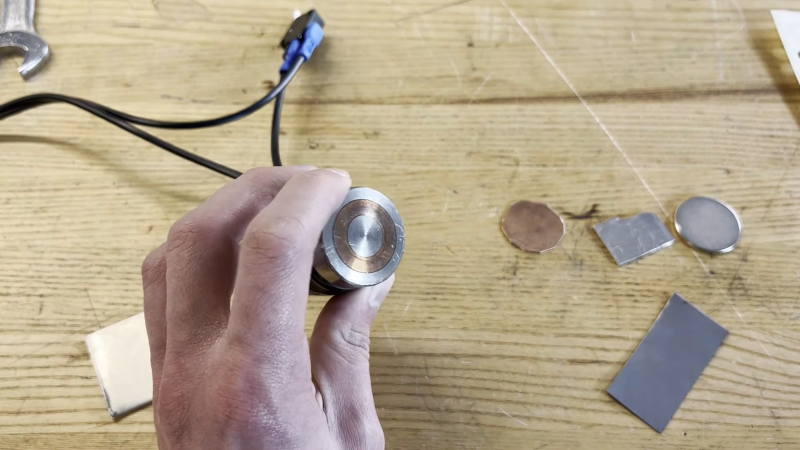It is a common grade school experiment to wind some wire around a screw, power it up, and watch it pick up paper clips or other ferrous materials. It is also grade school science to show that neither an electromagnet nor a permanent magnet will pick up nonferrous items like copper or aluminum. While technically not an electromagnet, it is possible to build a similar device that will weakly pull on copper and aluminum, and [Cylo] shows us how it works in a recent video you can see below.
The device sure looks like an electromagnet made with magnet wire and a steel core. But when he shows the ends of the core, you’ll see that the side that attracts aluminum has a copper ring embedded in it. The coil is fed with AC.
The magnetic field from the coil induces an opposite field in the copper ring that is out of phase with the exciting field. The two fields combine to produce a force on the metal it interacts with. This is often referred to as a shaded pole, and the same technique can help AC motors self-start as well as hold in relays driven by AC. If you want to see much more about aluminum floating on a magnetic field, check out the 1975 video from [Professor Laithwaite] in the second video below.
You probably have a shaded pole AC motor in your microwave oven. Or, maybe,your old 8-track player.

















I wonder if the same principle scaled up can be used to collect fine gold from a river
I tried this many years ago using a moderately large 220V shaded pole linear electromagnet fed by a 1kW portable generator. And yes, it worked, but only for somewhat larger nuggets. Unfortunately the induced magnetic field was not able to hlod those tiny flat gold particles that majority of the river gold is composed of to stick to the magnet strongly enough not to be washed out by the stream of water with sand in it. I planned to try higher frequency, say 400 Hz as it should potentially work better for small particles, but never did this, for my interest faded away.
What if the surface of the magnet had baffles to trap the gold?
I’d be concerned that it would attract “black sand” often found with gold even stronger.
“You probably have a shaded pole AC motor in your microwave oven. Or, maybe,your old 8-track player.”
Or pretty much every bathroom exhaust fan.
Considering a full bathroom exhaust fan assembly is less than $20, pretty cheap just to buy new. You can probably find be motor itself for even less.
This brings back memories of the “Master Magnet” a similar device, featured in a 1956 issue of Popular Electronics Magazine, November or December. The article explains how the device works and gives a detailed explanation of how to build it. It can be found on the Internet Archives.
https://archive.org/details/Pop195710/Popular%20Electronics/Pop-1962-09/page/n47/
What would it take to build one? or 20+? $$$. I tried static but not effecient enough. I have some sand with gold and tried several ways to economically extract. Don’t want to use chemistry as it is dangerous. thanks.
I just learned something. Thank you for posting this. I don’t recall ever being exposed to this in college class or labs.